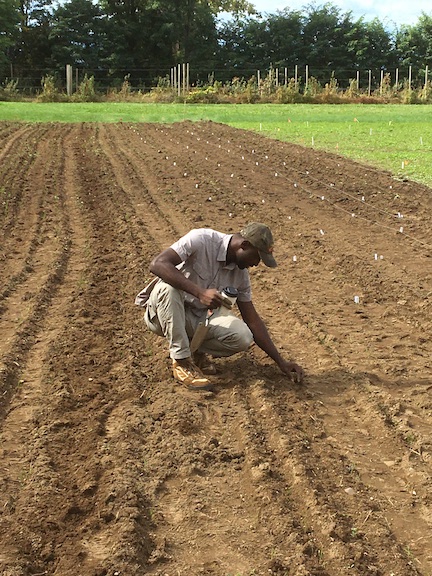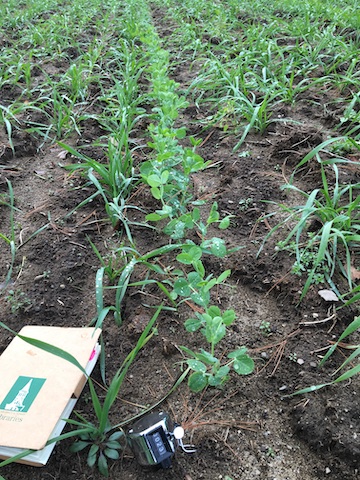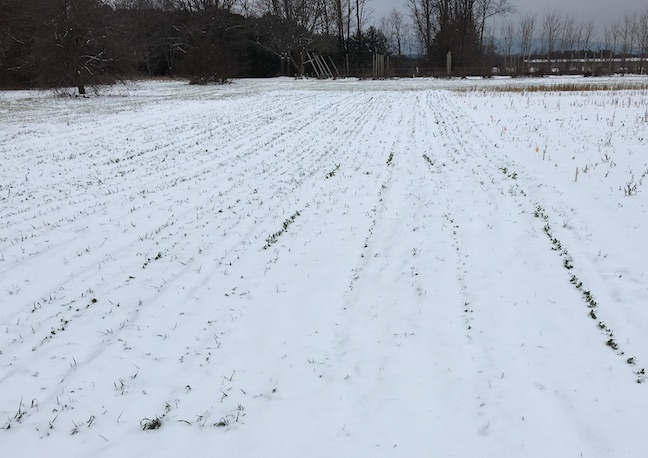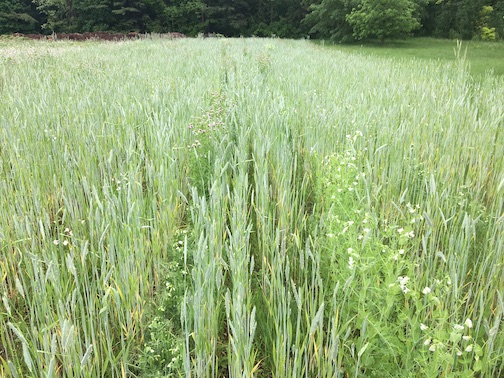By Emmanuel Brefo, Eric JB von Wettberg and Deb Heleba
As you plan ahead for the fall, are you considering cover crops? Would you be more likely to plant a winter cover crop if it were also an early spring vegetable you can harvest, while also reaping the ecological benefits of a cover crop? Our research is examining the feasibility of planting new vegetable types of winter peas in the fall to see if they can be harvested early in the spring as edible podded peas in New England.

Cover crops are an important tool for supporting soil health. Cover crops build soil organic matter, preventing erosion and building your soil “sponge.” Leguminous cover crops — members of the bean family like peas and clovers — can also increase soil nitrogen levels through their symbiosis with rhizobia, nitrogen-fixing soil bacteria. Although the benefits of cover cropping have been known for some time, some farmers and gardeners have not been able to take advantage of these crops due to the price of seed, labor, the timing at which cover crops need to be sown, or concern about trying something new and different. Cover crops that can also be harvested as a vegetable crop may overcome some of these challenges. We are working with Dr. Rebecca McGee, a legume geneticist with the USDA Agricultural Research Service (ARS) in Pullman, Washington, to trial vegetable peas that can be overwintered in the Northeast. She has crossed winter-hardy Austrian winter peas, a forage-type pea commonly used for cover crops, to sweeter but winter-intolerant snap peas for their potential as dual-use crops. Our research is evaluating a number of these crosses for their winter survival in northern New England, performance as a cover crop, and marketability as a vegetable crop.
For successful winter cover cropping, you need to blend the right selection of plant species together with specific agronomic management. While most peas cannot survive a northern New England winter, Austrian winter peas can survive winters in hardiness zone 4. We have observed higher survival with pea planting depths of 3 inches, although shallower depths may be needed in clay-heavy soils. Peas prefer a pH around 6.5 and do poorly in waterlogged conditions, and benefit from phosphorus and potassium.
Peas associate with a particular rhizobium, Rhizobium leguminosarum sv. Viciae, that are likely not present in soils where peas have not been recently grown. Therefore, in soils that have not previously been planted with peas, consider including a rhizobial inoculum treatment to ensure better nodulation with rhizobia and better nitrogen fixation (check with your organic certifier for the certified organic inoculants you can use). You can find more information on inoculants at eorganic.org/node/4439.
Deer and rabbits love overwintering peas due to a shortage of other food sources in the colder months, so fencing may be necessary to curb crop losses. In our trials, we also observed crop damage issues from cutworms and pea weevils. To help identify and manage insects that damage pea plants, from root nodules to pods, North Dakota State University Extension has put together a diagnostic tool, “Pulse Crop Insect Diagnostic Series: Field Pea, Lentil and Chickpea” (publication E1877). They also offer a “Pea Disease Diagnostic Series” (publication PP1790). Our research plots have seen some damping off, and we know that diseases like Aphanomycescan becommon challenges for pea production.

Peas at V4 stage (the vegetative growth stage at which the fourth multifoliolate leaf is present), captured on November 5, 2021. Emmanuel Brefo photo
The planting time for winter peas is often targeted in the fall after wrapping up the summer cropping season. We advise getting the seeds in the soil by the end of September, when the warmer temperatures can ensure better germination and root establishment before the plants overwinter. A sunny day in September is worth a week in October for plant growth. That said, we have had success with overwintering peas seeded at the end of September in zone 5a near Burlington, Vermont, giving growers more time for their summer and fall cash crops to remain in the ground. Planting time influences acclimation, a mechanism used by peas to gradually develop resistance to cold stress when the daylight and temperature drops. Peas require a well-established root system to overwinter, meaning that planting too late in the fall will not lead to successful overwinter survival.
Your plot size and planned density/spacing will determine the quantity of seed you will need for planting. Pea seeds weigh an average of 0.5 ounce per 100 seeds. We have been successful in spacing the plants at about 2 inches. Higher density is beneficial for some plants due to the insulation effect they have on one another as well as their greater benefit to soil health and weed suppression. And, a higher planting density may also provide a higher number of plants that survive the winter. We have not yet experienced significant weed problems in our overwintering pea trials. Winter cover cropping often helps with weed pressure as the cover crop can help compete against and suppress some weeds. The weeds we have observed tend to come in spring and can be managed organically after the spring pea harvest at the time of bed preparation for your next crop; any pea plant residue may be mulched or turned into the soil.

Peas are known to better tolerate low temperatures when covered with snow than without snow cover. Consequently, they tend to fare better if intersown with a cereal crop to give them some insulation from winter temperatures. The cereal companion can also help with weed suppression. Oats are a good option as they will provide some organic matter to soils before being winterkilled. Rye and triticale, with greater cold hardiness than overwintering peas, will provide greater insulation, but because they grow rapidly in spring, they may make vegetable pea harvest difficult. If you plan to harvest peas for biomass or livestock feed, or use for spring grazing by pastured livestock, these cereals are viable options.
Overwintering peas as a cash-generating cover crop can lower the input costs of growing a cover crop. Dryland production from fall to early spring is feasible due to adequate soil moisture from rain and snow. This saved us the energy costs that would have gone into irrigating the crops and also provided free nitrogen fertilizer for summer crops.

Availability of dual-use peas are limited — the overwintering peas we are researching are the intellectual property of USDA ARS. The good news is that they are nearing licensing, and we hope there will be interest among local seed companies and seed growers to make them commercially available within the next few years to interested farmers and gardeners. Until these varieties are available, Austrian winter pea types —cultivars like Windsor, Coyote and Wyndham — have good overwinter survival and are commercially available. Although not snow pea or snap pea types, if harvested immature, we find them perfectly tasty. We regularly struggle to keep our undergraduate assistants from nibbling on them!
Emmanuel Brefo is a graduate student at the University of Vermont (UVM) Department of Plant and Soil Science. Dr. Eric JB von Wettberg is an associate professor at UVM (Department of Plant and Soil Science and Gund Institute for the Environment) where he leads the Crop Genetic Heritage Laboratory and is happy to answer any question related to legumes. Deb Heleba coordinates the UVM Extension Master Gardener Program.
This article was published in the summer 2023 issue of The Maine Organic Farmer & Gardener, MOFGA’s quarterly publication.
